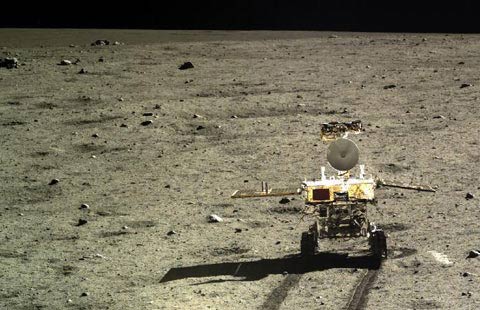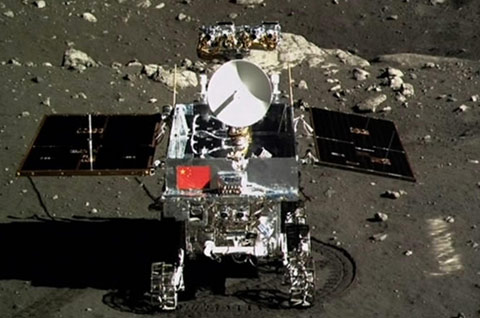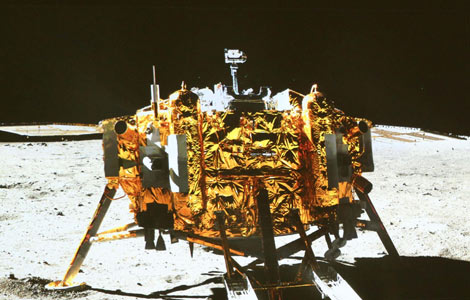

China launches Shenzhou X manned spacecraft with three astronauts.
 This undated photo taken by the camera on the Yutu moon rover shows the Chang'e-3 moon lander and the moon surface. The Chang'e-3 lander entered its third dormancy on early Feb. 23, 2014.
This undated photo taken by the camera on the Yutu moon rover shows the Chang'e-3 moon lander and the moon surface. The Chang'e-3 lander entered its third dormancy on early Feb. 23, 2014.
 China's moon rover Yutu "awakes" and is able to pick up signals despite still experiencing a mechanical control abnormality.
China's moon rover Yutu "awakes" and is able to pick up signals despite still experiencing a mechanical control abnormality.
 Chinese scientists will have to wait until the end of a long lunar night, lasting about 14 earth days, to see if repair efforts on the country's first moon rover, dubbed Jade Rabbit, were successful.
Chinese scientists will have to wait until the end of a long lunar night, lasting about 14 earth days, to see if repair efforts on the country's first moon rover, dubbed Jade Rabbit, were successful.
 China's moon rover, Yutu (Jade Rabbit), has experienced a mechanical control anomaly, and scientists are organizing repairs.
China's moon rover, Yutu (Jade Rabbit), has experienced a mechanical control anomaly, and scientists are organizing repairs.
The Chang'e-3 lunar probe has started its long-term scientific missions and will have its durability tested when it continues lunar surface surveys, sources with the Beijing Aerospace Control Center said Thursday.
China's moon rover "Yutu", or Jade Rabbit, completed its first scientific exploration of lunar soil on Tuesday, the Beijing Aerospace Control Center (BACC) said.
 A post on Weibo titled, "Chinese moon rover Yutu", suggesting the machine's survival after an icy lunar night, made a splash online, with Web users piling their joys over seeing the troubled machine's long-anticipated awakening.
A post on Weibo titled, "Chinese moon rover Yutu", suggesting the machine's survival after an icy lunar night, made a splash online, with Web users piling their joys over seeing the troubled machine's long-anticipated awakening.
 China's moon rover, Yutu (Jade Rabbit), worked in stable condition following its restart after a "nap" on Friday night.
China's moon rover, Yutu (Jade Rabbit), worked in stable condition following its restart after a "nap" on Friday night.
 Six out of the eight pieces of scientific equipment deployed to the moon with the Chang'e-3 lunar mission have been activated and are functioning properly.
Six out of the eight pieces of scientific equipment deployed to the moon with the Chang'e-3 lunar mission have been activated and are functioning properly.
 China's recent success in soft-landing a spacecraft on the Moon is a milestone in space history, experts said.
China's recent success in soft-landing a spacecraft on the Moon is a milestone in space history, experts said.
Five of the eight pieces of scientific equipment aboard Chang'e-3 lunar probe have started to observe space, the Earth and the Moon, a Chinese scientist said on Monday.
 China is scheduled to launch its Chang'e-5 lunar probe in 2017 and the mission will bring back samples collected from the moon.
China is scheduled to launch its Chang'e-5 lunar probe in 2017 and the mission will bring back samples collected from the moon.